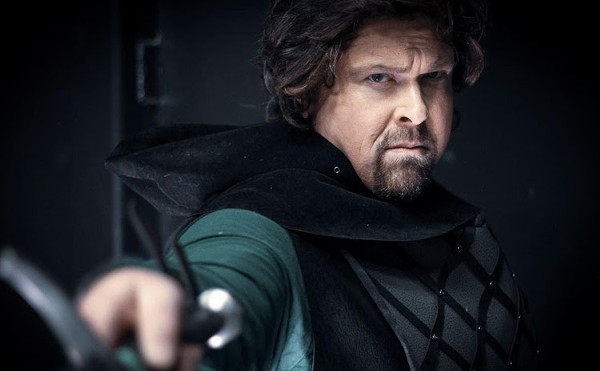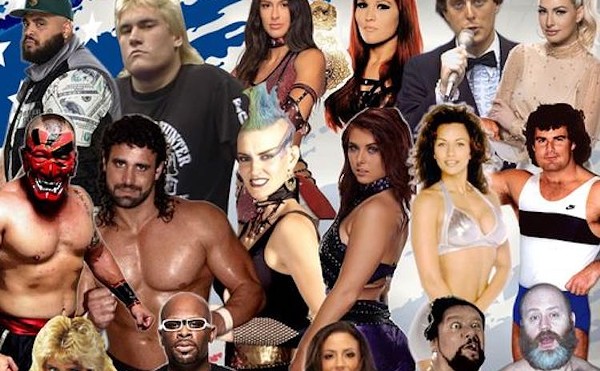"The Family Circus" it ain't.
Aside from its excess of exclamation marks, The Plot: The Secret Story of the Protocols of the Elders of Zion appears too intellectual – and too inflammatory – to share ancestry with the Sunday funnies or superhero stories. But this harrowing graphic novel, subject of a new special exhibit at Maitland's Holocaust Memorial Resource and Education Center, sprang from the same mind that helped invent our modern illustrated entertainment industry – not once, but twice.
If you've never visited the oldest Holocaust museum and research center in the Southeast, don't feel alone. I've lived here since 1996 and had never set foot inside the modest beige building abutting the Roth Jewish Community Center before now. Similarly, the vast majority of fans filling the seats at screenings of last summer's Dark Knight Rises and Avengers blockbusters probably wouldn't recognize the name Will Eisner, nor recognize the role he played in cultivating those characters' creators, not to mention the medium they played in.
Up until the mid-1930s, "comic books" simply reprinted newspaper strips into booklets. In 1936, a year before the Superman publisher Detective Comics (now simply known as DC) was born, Eisner created some of the first characters specifically intended for the comic book format for the short-lived Wow! magazine. Later that year, he founded the first successful comic book "packaging" company with partner Jerry Iger. By the time Will left the company in 1939, Eisner and Iger had given early employment to Batman creator Bob Kane, Avengers co-creator Jack Kirby and other influential artists.
(Incidentally, Eisner is no relation to the former Disney CEO and had no relationship with that company. But his authentic autograph is suspiciously similar to the familiar corporate logo loosely based on Walt's signature – which one came first has been hotly debated – and his partner Iger was, coincidentally, the grand-uncle of Disney's current CEO.)
Never satisfied with mere superpower slapstick, Eisner pushed the medium with morally complex stories that shone a spotlight on society's margins. Between 1940 and his death in 2005, Eisner created the widely read noir crime comic The Spirit (much better than the 2008 flop Frank Miller film may have led you to believe); developed illustrated instructional manuals for the U.S. Army while serving in World War II; and invented the term "graphic novel" for his 1978 book-length work A Contract With God and Other Tenement Stories.
That last title was the first of several exploring Eisner's ethnicity. Like Kirby, Stan Lee, Superman creators Jerry Siegel and Joe Shuster, and many others in the industry, Eisner's family were Jewish immigrants. (For a fictionalized but faithful view of this golden era in comic books, read Michael Chabon's Pulitzer Prize-winning 2000 novel The Amazing Adventures of Kavalier & Clay.) Eisner addressed anti-Semitism in a number of late-career works, including his revisionist examination of the character Fagin from Dickens' Oliver Twist. That theme became the central focus of his final graphic novel, The Plot, which inspired the Maitland institution's current installation.
In it, Eisner dissected the sordid history of "The Protocols of the Elders of Zion," the most notorious hoax document in modern history. Purported minutes from a mythical meeting of late-19th-century Jewish leaders, this bilious book "exposes" their supposed international conspiracy to destroy civilization. First published in Russia in 1903, it has been translated into countless languages and embraced as gospel around the world – most notably by Adolf Hitler, who frequently cited the Protocols as justification for Nazi atrocities, and by Henry Ford, who promoted it as fact in the 1920s through his Dearborn Independent newspaper.
In reality, as Eisner illustrates, the tract was a forgery crafted by agents of Tsarist Russia's secret police to discredit Bolshevik revolutionaries. The bulk of the text was lifted from a French political satire starring Machiavelli, whose quips were recast as Jewish jabs; not only were the Protocols' assemblers malevolent anti-Semites, they were lazy plagiarists, too. The Protocols' notoriety persists despite repeated debunking in the courts and the press, dating back to a 1921 exposé in the London Times and a 1934 Swiss trial that declared them "laughable nonsense." Throughout Eisner's recounting, well-intentioned characters repeatedly claim to "put an end to the Protocols once and for all," but it continues to be distributed as nonfiction in the Middle East, Asia and delusional corners of the Internet.
The Plot exhibit, which was created by the Anti-Defamation League in cooperation with Eisner's estate, occupies the center's rear room, past the permanent exhibits near the entryway and central library. Four wall-sized panels walk visitors through the origins, effects and eventual exposure of the Protocols, using reproductions of Eisner's drawings juxtaposed with historical timelines and contextual information. There are no original pieces of Eisner's art on display, nor any examination of the psychological motives or creative techniques he employed in completing such a weighty project during his final months. The exhibit's focus instead is on the historical record, leaving the viewer to resignedly wonder, "What next?"
That same question concerned center chairwoman Tess Wise, a Polish Holocaust survivor who helped found the memorial center in 1985, and who hopes to answer that question: "Never again." Wise wants to accomplish the goal of eradicating anti-Semitism through "remembrance and education," according to the center's special projects director Susan Mitchell. Therefore, the center's focus isn't solely on the past, but also current issues like bullying. Mitchell hopes The Plot, like their 2000 exhibit on Art Spiegelman's Maus, will attract a contemporary audience to hear warnings against embracing divisive propaganda, especially in our age of online "information and misinformation."
"We talk about tolerance, which is such an uncomfortable word," Mitchell says, "[when] we really need to tolerate our own discomfort" with religions or cultures different from our own. "It's not our differences that make the world go 'round; it's our sameness."
The Plot: The Secret Story of the Protocols of the Elders of Zion
through March 15
Holocaust Memorial Resource and Education Center
851 N. Maitland Ave., Maitland
407-628-0555
holocaustedu.org
free
















